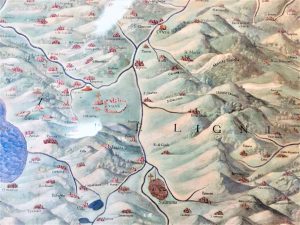As I prepared for a recent visit to Europe, I conducted some preliminary research, both on the new destinations I would be visiting and on my ancestral patrilineal village, where I would be staying for a few days. Like many readers, I revel in the historical aspects of travel, and I try to make connections to my personal genealogy whenever possible. Understanding the context in which an ancestor lived adds so much more complexity and depth to characters who may otherwise only appear in birth, marriage, and death records. Paying attention to details that are not immediately relevant can often lead to great future discoveries.
While in Rome in May 2017, my brother and I were enchanted by the frescos that make up the Gallery of Maps at the Vatican Museum. Forty spectacular images capture the settlements and landscapes that characterized sixteenth-century Italy. Pope Gregory XIII (1572–85) had commissioned the project, and the cartographic murals were completed between 1580 and 1585.[1]
Although we struggled to resist the wave of impatient tourists rushing toward the Sistine Chapel – armed with selfie sticks, fanny packs, and video cameras – my brother and I planted our feet and held our ground until we had located each of our ancestral towns. The frescoes are remarkably detailed – the bell towers are even visible in each little drawing of each town. Walls, towers, forests, and open fields vary the scenes. Each locale is carefully labeled, and diocese centers are denoted with a large crucifix.
What sketches, maps, letters, and memories made their way back to Rome to compile such a monumental body of information?
As a genealogist and a historian, it’s impossible not to wonder about the provenance of all this material. What sketches, maps, letters, and memories made their way back to Rome to compile such a monumental body of information? What exactly did those surveyors, scattered across the Italian peninsula, see? Someone presumably walked among my own ancestors more than 430 years ago while surveying little Pentima (now called Corfinio) and its environs. What was life like when my ancestors lived there in 1580s? What did those people endure? What isn’t obvious in the written record?
I have reviewed many of the vital records for the town (many parish records from 1580 onward survive). Of course, these specific records are invaluable, but sometimes you can lose the forest for the trees. What was happening in the town at a grander scale, beyond my own ancestors and their associates?
Italy did not exist as a unified county until the late 1860s. In prior centuries, the peninsula had been carved up as distinct kingdoms. The region from which my family hails, Abruzzo, was part of the Kingdom of Naples and the Kingdom of the Two Sicilies.
In the early nineteenth century, Lorenzo Giustiniani compiled a “Dizionario geografico-ragionato” (a regional/geographic encyclopedia) in which he provided data on all of the towns in the Kingdom of Naples for King Ferdinand IV of the Two Sicilies.[2] These volumes contain interesting details about each settlement’s major crops, its geography, its overlords, and its history. I find the population statistics most fascinating. Using tax records, Giustiniani was able to determine the number of “fuochi” (literally, hearths – here the word means households) in each town over long periods of time.
The following information was available for Pentima:
1537 – 91 households
1545 – 114 households
1561 – 147 households
1595 – 144 households
1648 – 154 households
1669 – 206 households
1737 – 169 households
The population decline from 1669 to 1737 surprised me. What accounted for that? I wondered if something unique had occurred in Pentima. I looked for entries relating to neighboring towns.
The neighboring town of Pratola Peligna had population statistics that demonstrated the very same trend:
1532 – 86 households
1545 – 105 households
1561 – 125 households
1595 – 159 households
1648 – 200 households
1669 – 226 households
1737 – 126 households
Here the decline was even more severe, however. One hundred fewer households were present in 1737 than 1669, likely half as many individuals as a century earlier.
In Popoli, another nearby town, the decline began somewhat earlier, but there was still a downward trend. This decline did not fit perfectly with Pentima and Pratola.
1532 – 163 households
1545 – 197 households
1561 – 262 households
1595 – 317 households
1648 – 341 households
1669 – 295 households
[1737] – 275 households
I conducted some general research on the region, and soon learned that Abruzzo had suffered two terrible earthquakes in 1703 and 1706. The 1706 earthquake seems to have hit Pentima and the surrounding towns more severely.
An account from the early eighteenth century relates the destruction that occurred in 1706:
A Pentima in finora si sono scavati 150 morti, tra gli quali fu trovato un busto piu di 30 passi lontano dalla sua testa.
“In Pentima in total 150 dead were discovered, among them a torso was found more than thirty paces from its head.”[3]
I requested that a colleague in Italy visit the ecclesiastical archive for me to see if this report could be corroborated by the records in the parish registry. He was able to locate an entry in the Libro Mortuorum for the town (the parish register for deaths).
In his initial count, the parish priest noted more than sixty deaths on 3 November 1706. The heading for the entry reads “Die 3 9bris in terremota perierunt infrascripti” – “On the 3rd day of November, the individuals listed below perished in the earthquake.” Among the dead was among them a distant great-uncle of mine, Michele Ferzoco, who died tragically at the age of six. Michele had survived the most difficult years of childhood – he had not died in infancy like so many others – only to be killed in the earthquake.
“On the 3rd day of November [1706], the individuals listed below perished in the earthquake.”
Because so many individuals died in the earthquake, the parish priest was unable to document each death with his typical specificity. Usually the priest documented the full name of the deceased, the names of a parent or a spouse, the age at death, the place of burial, and whether the individual had confessed his or her sins. To uncover some of these lost details, a tremendous amount of research on the entire town during the period is necessary.
If one hundred and fifty individuals did indeed perish in November 1706, the town must have been entirely devastated. This figure would account for 10% of the entire population. Only twenty-five individuals had died in Pentima during all of 1706 up until that point, many of whom were infants or young children. In contrast, many of the victims of the 1706 earthquake were young women and older children. In addition to the dead, the destruction of homes, churches, and warehouses would have been especially difficult to endure in early November, as winter weather encroached on the region. The number and severity of non-fatal injuries is unknown, although it is likely that many survivors suffered severe injuries.
One can imagine the devastation of the 1706 earthquake by considering more recent events. The 2009 L’Aquila earthquake devastated the region – Abruzzo’s capital city is still in disrepair almost a decade later. For comparison’s sake, that earthquake killed 309 individuals.
Knowing that my own ancestor, Felice Alessandro Ferzoco, survived the earthquake gives me a much deeper sense of his life. Considering the unanswerable questions begins to humanize faceless names and dates. I can’t help but wonder what my predecessors endured. Who recovered little Michele’s body? What were the funerals like in the aftermath of the disaster? How bad were the injuries? How long did it take for the town to repair ruins? For how many years did survivors recall that day? When were the dead ultimately forgotten? Even the briefest consideration of these kinds of questions helps resurrect individuals now long-forgotten.
Continued here.
Notes
[1] “Gallery of Maps,” VaticanState.va, accessed 22 February 2018, http://www.vaticanstate.va/content/vaticanstate/en/monumenti/musei-vaticani/galleria-delle-carte-geografiche.paginate.1.html.
[2] Lorenzo Giustiniani, Dizionario Geografico-ragionato, accessed via GoogleBooks, 22 February 2019, https://books.google.com/books?id=QZtjAAAAcAAJ&pg=PA147&dq=pentima+1537&hl=en&sa=X&ved=0ahUKEwjvzfbX5M_gAhWjV98KHWzYBGAQ6AEIQTAD#v=onepage&q=popolo%201537&f=false.
[3] Marchesa di Vigliena, Distina Relazione del danno cagionato dal tremuoto succeduto a di 3 di novembre 1706, accessed via GoogleBooks, 22 February 2019, https://books.google.com/books?id=2TATQjfVqRIC&pg=PR6&dq=tremuoto+pentima+1706&hl=en&sa=X&ved=0ahUKEwj_69rhgNDgAhVoc98KHTQMDMoQ6AEIKjAA#v=onepage&q=tremuoto%20pentima%201706&f=false.
Share this:

About Alessandro Ferzoco
Alessandro graduated from Harvard University with an A.B. in History. While a student, he worked at Widener Library assisting patrons with research and training new employees. He is a lifelong resident of Boston, and enjoys local and social history. He is particularly interested in New England, Irish, and Italian ancestries. In 2017 he traveled to Italy to conduct research, and he has traced his patrilineal family to the early 1600s. He enjoys deciphering manuscripts and Latin parish records.View all posts by Alessandro Ferzoco →
